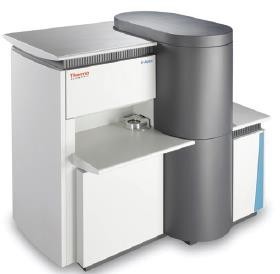X-ray Photoelectron Spectrometer (XPS)
XPS (X-ray Photoelectron Spectrometer)
High-Precision Analysis of Surface Chemical Composition

Thermo Scientific K-Alpha XPS device
Description
X-ray Photoelectron Spectroscopy (XPS) is a surface analysis technique that provides information about the chemical state of atoms present on the surface of solid samples. In this method, the atoms or molecules on the examined surface are bombarded with X-rays, and the kinetic energy of the emitted photoelectrons is measured to determine the elemental and chemical composition of the surface. XPS is used for the analysis of elements, inorganic compounds, metal alloys, semiconductors, polymers, catalysts, glass and ceramics, paints, inks, papers, cosmetics, as well as dental and bone samples and medical prostheses.
Applications
- Determination of surface chemical composition (0–10 nm depth)
- Identification of simple formulas of pure substances
- Analysis of contaminated surfaces
- Identification of the chemical state of species on the surface
- Determination of elemental/compound diversity on the surface (line profiling or mapping)
- Surface etching with ion beam (depth profiling)
Device Hardware and Technical Specifications
Device Name: Thermo Scientific K-Alpha
Analyzer: 180° hemispherical analyzer, 128-channel detector
X-ray Source: Monochromatic Al Kα
X-ray Spot Size: 30–400 µm
Sampling Area: 60 × 60 mm
Maximum Sample Thickness: 20 mm
Ion Gun (Argon): 100–4000 eV energy range
Vacuum System: 2 × 220 L/s turbo molecular pump
Additional Features: Depth profiling, real-time data acquisition, tilt module for ARXPS
Log in to the Erasis system to submit an analysis request.










